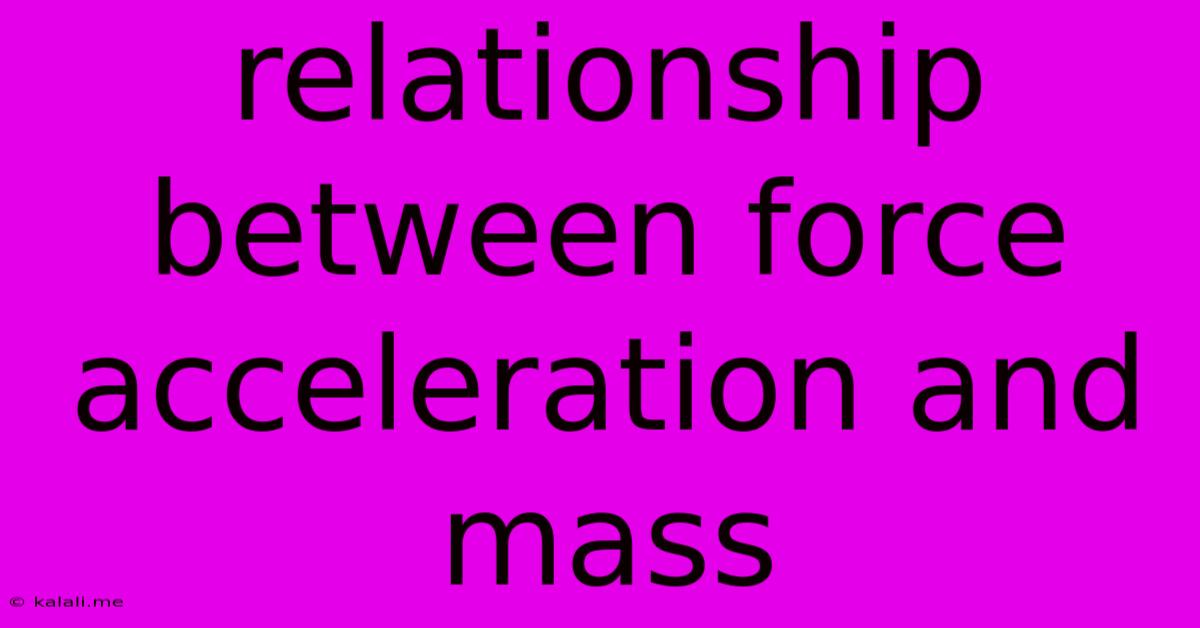Relationship Between Force Acceleration And Mass
Kalali
Jun 15, 2025 · 3 min read

Table of Contents
The Intertwined Dance of Force, Acceleration, and Mass: Understanding Newton's Second Law
Understanding the relationship between force, acceleration, and mass is fundamental to comprehending how objects move. This relationship is elegantly summarized by Newton's Second Law of Motion, a cornerstone of classical mechanics. This article will explore this vital connection, explaining the concepts involved and illustrating them with real-world examples.
Newton's Second Law: The Equation of Motion
At its core, Newton's Second Law states that the acceleration of an object is directly proportional to the net force acting on it and inversely proportional to its mass. This is often expressed mathematically as:
F = ma
Where:
- F represents the net force acting on the object (measured in Newtons). This is the sum of all forces acting on the object; if forces are acting in opposite directions, they are subtracted.
- m represents the mass of the object (measured in kilograms). Mass is a measure of an object's inertia – its resistance to changes in motion.
- a represents the acceleration of the object (measured in meters per second squared). Acceleration is the rate of change of velocity.
Understanding the Components:
1. Force (F): A force is any interaction that, when unopposed, will change the motion of an object. Forces can be pushes, pulls, or any other interaction that causes a change in velocity. Examples include gravitational force, friction, and applied force.
2. Mass (m): Mass is an intrinsic property of matter. A larger mass means a greater resistance to changes in motion. Think of pushing a shopping cart versus pushing a car – the car's much larger mass requires significantly more force to achieve the same acceleration.
3. Acceleration (a): Acceleration is the rate at which the velocity of an object changes over time. It's not just about speeding up; it also includes slowing down (deceleration) and changes in direction. A constant velocity means zero acceleration.
The Relationship in Action:
Let's examine how these three elements interact:
-
Increased Force, Constant Mass: If you increase the force applied to an object while keeping its mass constant, its acceleration will increase proportionally. For example, pushing a shopping cart harder will make it accelerate faster.
-
Increased Mass, Constant Force: If you increase the mass of an object while keeping the applied force constant, its acceleration will decrease proportionally. Adding heavy groceries to your shopping cart will make it accelerate more slowly for the same pushing force.
-
Increased Force and Increased Mass: The effect of changing both force and mass depends on the relative magnitudes of the changes. If the force increase is greater than the mass increase, the acceleration will still increase. Conversely, if the mass increase is greater than the force increase, the acceleration will decrease.
Real-world Applications:
Newton's Second Law governs countless phenomena:
-
Rocket Launches: Powerful engines generate immense force to overcome the rocket's significant mass, resulting in upward acceleration.
-
Car Acceleration: The engine's power provides the force to accelerate the car, with the car's mass affecting how quickly it speeds up.
-
Sports: In sports like baseball or tennis, the force applied to the ball determines its acceleration and, subsequently, its trajectory.
-
Everyday Movement: Every time you walk, run, or jump, you're applying force to your body to overcome inertia and achieve acceleration.
Conclusion:
The relationship between force, acceleration, and mass, as defined by Newton's Second Law (F=ma), is a fundamental principle governing motion in the universe. Understanding this relationship provides a framework for analyzing and predicting the movement of objects, from subatomic particles to celestial bodies. By mastering this concept, you gain a deeper appreciation for the mechanics of the world around us.
Latest Posts
Latest Posts
-
Which Of The Following Is Not One Of The
Jun 15, 2025
-
Which Of The Following Is A Steroid Hormone
Jun 15, 2025
-
What Is The Measure Of Angle E
Jun 15, 2025
-
Lines Of Symmetry Of A Regular Hexagon
Jun 15, 2025
-
The Function Of The Dartos And Cremaster Muscles Is To
Jun 15, 2025
Related Post
Thank you for visiting our website which covers about Relationship Between Force Acceleration And Mass . We hope the information provided has been useful to you. Feel free to contact us if you have any questions or need further assistance. See you next time and don't miss to bookmark.